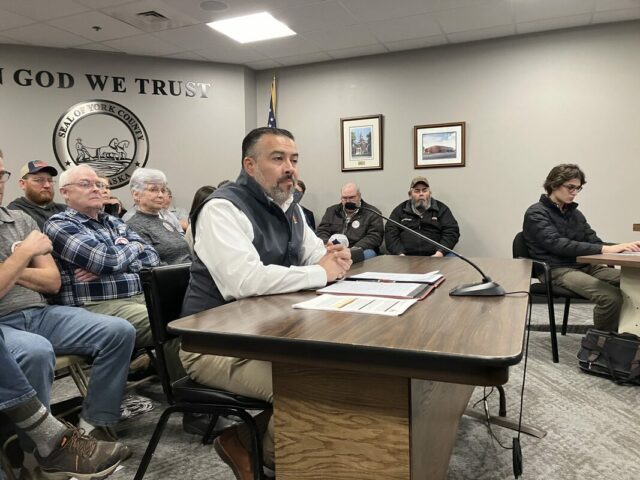Javier Fernandez, president and CEO of OPPD meets with York County Commissioners
| Writer’s note: This is the second installment in a series of articles stemming from the lengthy and detailed meeting this week before the York County Commissioners, regarding solar project zoning regulations. YORK COUNTY – Javier Fernandez, the president and CEO of the Omaha Public Power District (OPPD), had a long public conversation with the York County Commissioners this week, as OPPD is pursuing the development of the proposed K Junction Solar project near McCool Junction. “I appreciate you having me here today and for having the opportunity to hear all who spoke,” Fernandez said, in reference to the many people who addressed the board prior to his speaking. “We talked about the regulations this morning, which are a foundation for responsible project development. These proposed regulations are too restrictive in allowing the landowners’ rights. I believe this is a way for us to achieve a compromise. We are very committed to engaging with all of you, to make sure all voices are heard. Nebraska is the only state in the nation where 100% of electricity comes from public entities. OPPD recently surveyed York County residents with the majority saying they approve of landowners being able to use their land the way they see fit and a majority are in favor of solar power. York County will benefit and prosper from the K Junction Solar project. “There was a question as to why are we doing this,” Fernandez continued. “The energy landscape is changing. Nebraska is the envy of a lot of utilities because we are open for business and we are growing as a state when it comes to electric power usage. Virtually every power entity is experiencing growth and we are in a building mode which is fantastic. The United States, without a doubt, is the most powerful and prosperous country in the world. We’ve always had electricity available, we don’t think twice if there is enough power to power our businesses. We are committed to creating a diverse portfolio. “We are governed by an 8-person board, their voting record speaks volumes. They are clear in their mandates to serve the people,” he said. “We listen to our engineers and we need (diversity of power sources) and as fast as we can. We have four coal plants which have been operating since the 1950s and we had to shut them down when freezing temperatures froze the rivers. It was worrisome. But that same freezing wind created power (with the wind farms). So when one is down, another will be generating. We operate many facilities of all types within the state. We’ve been harvesting energy very successfully, in an efficient way. There are tangible benefits for York County – we ask for regulations to be conducive for property owners.” “In your service area for OPPD, how many counties does that include?” asked Commissioner Chairman Randy Obermier. Fernandez said it numbers 13. “Are any other utilities you operate outside of that footprint?” Obermier asked. Fernandez said yes, about 1,000 megawatts, all wind-generated. Obermier noted how York County residents do not vote for OPPD board members, as they do not live in the OPPD jurisdiction. “What do you say to them?” Fernandez said the OPPD board members invite and welcome everyone in the public. “We are held accountable by the public. We are accountable to all Nebraskans. We make an effort to work with counties. We will stand by these facilities and when it comes to decommissioning, we will be here. We will take care of it.” “The power is in the people who are sitting behind you,” Commissioner Jack Sikes said to Fernandez, referring to the large number of York County residents wearing buttons indicating they were against industrial solar projects. “And sooner or later, someone will try to use eminent domain. Hopefully in a year, we will have a United States administration with a whole bunch of new ideas. The people behind you have the power to say ‘no, I will not give you an easement to my land.’” “Thank you,” Fernandez said to Sikes. “I’ve been very clear regarding eminent domain. We will not pursue eminent domain for this facility. We can, but it is very, very rarely ever used.” “I also don’t believe this is low cost and efficient energy,” Sikes said. “I’m sitting on the hot seat every day to make sure we keep the power going,” Fernandez said. “It is troubling to me that this important, crucial industry has been politicized as it has. Administrations (United States presidential administrations) will come and go, but we are investing in energy for 30, 40, 50 years. Solar is part of that solution. We are building both natural gas and solar facilities. It may be hard for some to understand how urgent it is for us to build more projects.” “My question is why pick on prime farm ground?” asked Commissioner Stan Boehr. “Why not go to less desirable land that is not being used and where there is no irrigation? Why not go to places where you aren’t interfering with peoples’ lives?” Fernandez said it is a matter of transmission. “We looked at York County because of the transmission infrastructure.” “I think you could do this elsewhere,” Boehr said. “Not in a timely manner,” Fernandez responded. Commissioner Daniel Grotz asked how many acres OPPD has dedicated to natural gas facilities. Fernandez acknowledged solar fields take “a lot of land” but also said coal and natural gas plants “need a ton of water, railroad access and pipelines. We are trying to have a diverse portfolio, with technological and geographical diversity.” “It is a worry for me that solar fields use so much land,” Grotz said. “I’m worried we are taking one issue and creating another issue.” Grotz talked about how his great-uncle moved here, from Colorado, many years ago, to farm. “Even back then, people said he was moving to the greatest farmland in the United States. This project is taking a huge amount of crop land out of production.” “It’s a lot of land, yes,” Fernandez said. “But I’m excited about the technology coming in the next 10-20 years,” for other power sources. “It will take a while, so we are using available resources to help us to continue to grow. We will take care of the decommissioning.” He also said the land used for the solar field would not be greatly disturbed. “I don’t believe anyone in this room believes the land will be the same as it was while in production, after a project like this is decommissioned,” Grotz said. “There has also been a push by those who are pro-solar, who push the thought that farmers use a lot of pesticides. In this area, we have terrible intrusive weeds we control with tillage. How would you keep down the weeds?” Fernandez said they have had “good success with pollinators.” “Size-wise, regarding acres, what is the largest solar plant you have now in Nebraska?” asked Commissioner LeRoy Ott. “Because here, we live by acres.” Fernandez said the solar project currently being built in Saunders County is 600 acres. “And the money (coming into the county and the school district) seems to be a moving target,” Ott said, “as far as what the community will get, the county will get. My other question is about the money you offered the farmers when you first signed them up, what are you offering now? And a 30-year lease is a long lease.” “We are committed to property rights and leaving the land in the hands of the farmers,” Fernandez said. “We bought the project from EDF – landowners will continue to own their land. We will not own the land, there is no reason to own the land. The property owners will continue to pay their taxes and there will be an additional name plate tax on the project, which we estimate will generate an extra $700,000 for the school district and $200,000 for the county, in addition to the existing property tax. Again, we bought the contracts EDF already negotiated.” “One thing you need to take back to your board is the question of whether they want to live next to one of these solar projects,” Ott said. “What I hear, from people who say they are for it, is that they are for it as long as it’s not by their property. York County and Hamilton County are number 9 and 10 for corn production in the world. That has to be said.” “I’m asking for dialogue toward reasonable regulations,” Fernandez said. “As far as the name plate tax, OPPD would be exempt from the name plate tax, correct?” asked Grotz. Fernandez said that is the case. But he also said OPPD does not own any renewable energy facilities. “It is not our intention to own this. The intention is to put this out for bids from developers. As soon as we have all the permits, we will put out for bids and the developer will pay the name plate tax.” “Would OPPD consider owning and operating a renewable energy facility?” Grotz asked. “I can’t speak for my board but my answer would be no,” Fernandez said. “I can tell you that is incredibly unlikely.” “You say you can’t speak for your board, but neither can we,” Grotz said. “If your board members change their minds, we have no recourse and that’s the worry of my constituents.” “I can’t speak for the board, but we could put that in writing,” Fernandez said, regarding the OPPD’s board intent to bid out for a developer, which would then pay the name plate tax. “Regarding noise levels and heat transfers, what can we expect?” asked Obermier. OPPD’s Brad Underwood said it would sound like a faint electric yard trimmer, if at all. “Noise is not an issue with these facilities.” “Now on the heat, what are we looking at?” Obermier asked, regarding local concerns about animal feeding operations. Underwood said, “the panels are designed to accept radiance,” not to push out accelerated temperatures. He also said he would provide more information for the commissioners, regarding heat. “We are the number one county in corn production in Nebraska, why would we want to do away with that? That’s something we need to think about,” Obermier said. “And where are you at with the timeline of going live?” Underwood explained how the location of the transmission line isn’t as important as the capacity of the transmission line being able to accept the new energy. The OPPD officials said it will be about a 30-month build for the project. Fernandez said he would take back to the OPPD board the York County request for a letter of intent regarding the quest for a third-party developer, to ensure the name plate tax payments would be a reality. “It’s not just about the money,” Obermier said. “I hope your board understands this has split that community and there is no dollar figure to equal those damages. I hope you recognize that. And I hope you also recognize that while these York County residents don’t agree with you,” referring to the large contingency in attendance, “they are still respectful.” “It’s been an honor to be here,” Fernandez said. “To be able to have this type of dialogue. I have one mission – to keep power flowing and keep Nebraska open for business and growth. A project like this is a must have. I commend how much care you have all taken.” Writer’s note: There will be a third installment on this subject, regarding the county commissioners’ further discussion on zoning regulations pertaining to solar projects. |




































